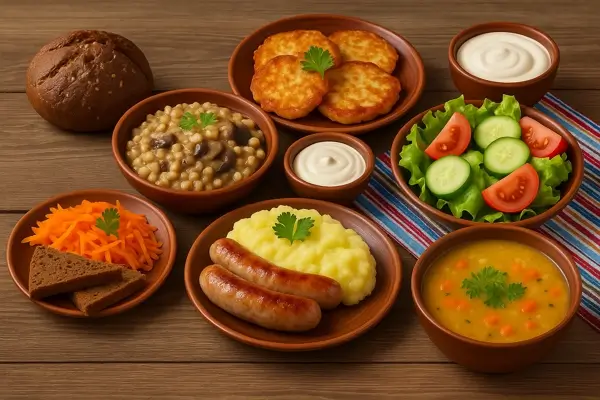
Estonian cuisine is a delightful fusion of flavors, combining traditional Nordic influences with influences from neighboring countries. The country's culinary scene reflects its natural surroundings, with an emphasis on fresh, seasonal ingredients. From hearty soups to savory pastries, here are some national dishes and local specialties that define Estonia's gastronomy.
Verivorst: Verivorst, also known as blood sausage, is a traditional Estonian dish commonly enjoyed during the Christmas season. It is made by combining pork blood with barley or other grains, along with spices and seasonings. The mixture is then stuffed into casings and cooked until firm. Verivorst is often served with sauerkraut and lingonberry jam. Recipe
Mulgipuder: Mulgipuder is a hearty Estonian dish made from potatoes and groats. It consists of mashed potatoes mixed with barley or other grains, along with fatty pork. The dish is typically topped with bacon and served with pickles. Mulgipuder is a comforting and filling meal, perfect for cold winter days. Recipe
Kama: Kama is a traditional Estonian powdered cereal mix made from roasted barley, rye, oats, and peas. It is often mixed with buttermilk or yogurt and sweetened with honey or sugar. Kama is a popular breakfast or snack option and is known for its nutty flavor and high nutritional value. Recipe
Kiluvõileib: Kiluvõileib is a classic Estonian open-faced sandwich made with dark rye bread, butter, and marinated Baltic herring. It is commonly garnished with sliced boiled eggs, red onions, and fresh dill. Kiluvõileib is a beloved snack or light meal option, offering a combination of savory, salty, and tangy flavors. Recipe
Karask: Karask is a traditional Estonian bread or flatbread made from a mixture of barley or rye flour, buttermilk, and eggs. It is often flavored with caraway seeds or juniper berries. Karask can be served as a side dish or as a base for various toppings, such as butter, cheese, or smoked fish. Recipe
Rosolje: Rosolje is a traditional Estonian salad made with boiled and diced beets, potatoes, carrots, and pickles. It is typically dressed with sour cream or mayonnaise and garnished with chopped herring, boiled eggs, and fresh dill. Rosolje is a colorful and flavorful salad commonly enjoyed during festive occasions. Recipe
Õunakook: Õunakook is an Estonian apple cake made with a buttery pastry crust and filled with sliced apples and cinnamon. It is often served with a dollop of whipped cream or a scoop of vanilla ice cream. Õunakook is a popular dessert, capturing the essence of Estonia's apple-growing heritage. Recipe
Leivasupp: Leivasupp, or bread soup, is a traditional Estonian dessert made from stale bread, typically rye bread, soaked in sweetened water or milk. It is often flavored with cinnamon, cardamom, and dried fruits such as raisins. Leivasupp is a simple yet comforting dessert, enjoyed warm or chilled. Recipe
Hapukapsasupp: Hapukapsasupp is a tangy sauerkraut soup commonly prepared in Estonian households. It is made by simmering sauerkraut with pork, potatoes, carrots, onions, and spices. Hapukapsasupp is a hearty and flavorful soup, often served with a dollop of sour cream and accompanied by freshly baked bread. Recipe
Leib: Leib, or Estonian black bread, is a staple in Estonian cuisine. It is a dense and hearty rye bread, traditionally baked using a sourdough starter. Leib has a rich, earthy flavor and a firm texture. It is often enjoyed with butter, cheese, or various toppings, and is an essential part of Estonian meals. Recipe
These are just a few examples of the national dishes and local specialties that showcase the unique flavors and culinary traditions of Estonia. Exploring Estonian cuisine provides an opportunity to experience the country's rich food culture and indulge in delightful culinary experiences.
